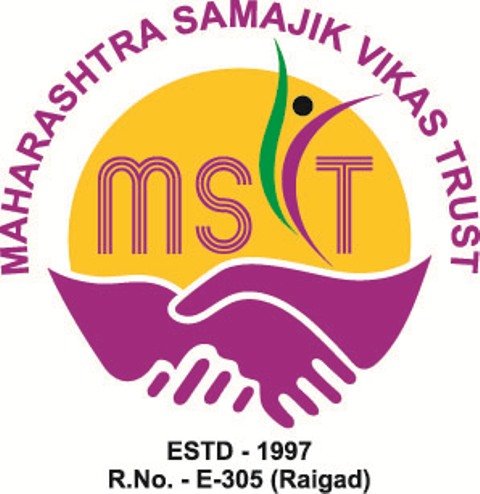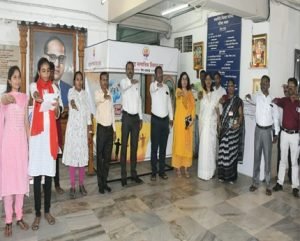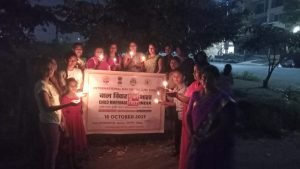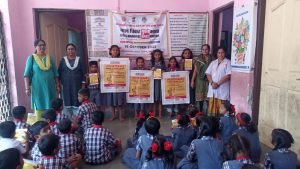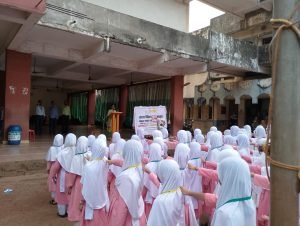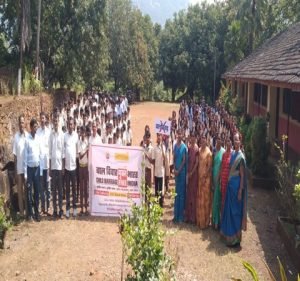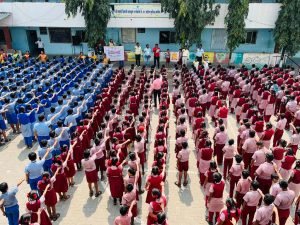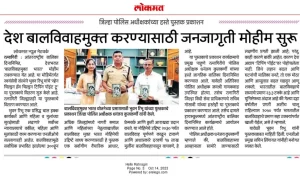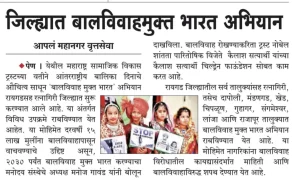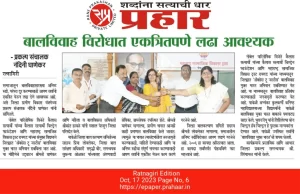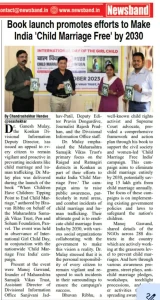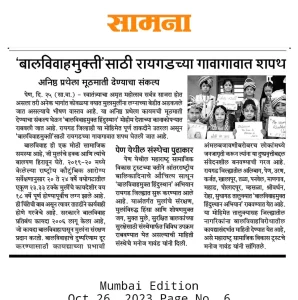Our NGO Work
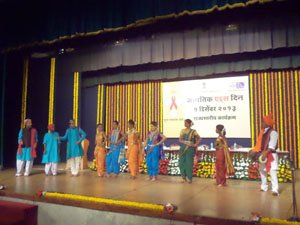
HIV/ AIDS People’s Awareness Program
The organization has carried out the awareness programmes in all Talukas, All revenue villages, Primary health centers , District hospitals, Rural Health centers and Rural Hospitals, Schools Colleges etc. in three Districts namely THANE, RAIGAD, PUNE, SANGALI, RATNAGIRI and PARBHANI. Various programmes like Road shows, Musical concerts, Dandia rass, in Navratri. Display of Posters and informative material, during the Ganpati Festivals etc. were arranged in a very attractive manner to create awareness about the HIV/ AIDS and its effects, covering all the classes of the society. This has become a regular feature and these activities are being carried out, with devotion.

T.B. Awareness Program
This project was started from March 2011, covers almost 10 lakhs population. Main objective is aware the people about T.B. inform them the causes of T.B. infections as well as symptoms of T.B. & reduce the stigma & discrimination against T.B. patients & their families. We coordinate with SHG groups, Self help groups, and religious groups like Muslims & with panchayat institutions for awareness. We empower peoples & communities affected by T.B., improves the case detection & treatment adherence.
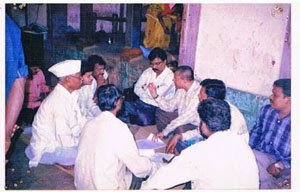

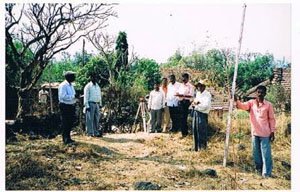
Bharat Nirman Rural Water Supply
The main trust was on the visits to all the rural Gram Panchayats and organizing villages meetings to give them the information and guidance on the following important aspects of the project. Study of the water resources. Assessment of the required water supply in proportion with the population. Supply of water by introducing water supply schemes Tube wells, water connections etc. Small Reservoirs availability. Wells. Small bunds for storage of water. The possibility of undertaking such schemes providing water to the rural area to suit the needs of the villages concerned and preparation of the project and seeking the sanction of the Zilla Parishad, completing the total project and handing over the said projects to the Gram Panchayats concerned for execution etc. is efficiently done. The Gram Panchayat authorities have been provided with able guidance to prepare such projects on their own and implement them.

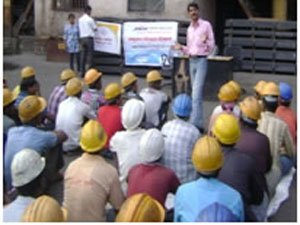
Health Safety / Protection Project (Target Intervention- Migrant)
This Project was started from Dec. 2008 it is meant for Dist Raigad & the detailed assessment & study of the single migrant who have come from his own native place, outside the state & the migrants who are unable to visit their residential places for more than three to six months. This number of migrant is more than 25,000.
This project was started from March 2011, covers almost 10 lakhs population. Main objective is aware the people about T.B. inform them the causes of T.B. infections as well as symptoms of T.B. & reduce the stigma & discrimination against T.B. patients & their families. We coordinate with SHG groups, Self help groups, and religious groups like Muslims & with panchayat institutions for awareness. We empower peoples & communities affected by T.B., improves the case detection & treatment adherence.

Health Safety / Protection Project (Target Intervention- FSW)
This project was started from July 2009 this project is mainly meant for District Raigad & prostitutes and the women doing the same business, having covered under this project. The target for 2009-2010 is to provide all the guidance & Assistance to such women human indulged in this business. The survey of 2800 cases in the projected area has been done. The main objective behind this survey is preventing the spread of HIV/AIDS. Blood investigation facility & free medical aid is provided through the Govt. dispensary. Not only that all the important & possible information & guidance regarding the spread of HIV/AIDS is given & Condom demo is organized & distribution of Condom free of charge & other facilities have been provided with.
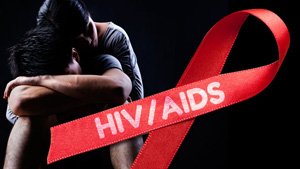
Health Safety / Protection Project (Link Worker Scheme)
This project started from March 2010, it covers all the targeted population which is 4.2 lakhs approx of Raigad District. The target population includes FSW, MSM,IDUs under high risk group & Migrants, Truckers as well as their spouses, youth group both male, female under Vulnerable population. LW scheme covers 100 villages of Raigad district & 40 link workers works with project that are the pillars of LW scheme. They identifies the high risk group & vulnerable population in the villages, spreads the knowledge about HIV/AIDS among the targeted population. They establish the Information centers at each village as well as establish the condom depots also. Blood investigation facility & free medical aid is provided through the Govt. dispensary. LW scheme works for the betterment of the lives of those people who are infected by HIV or those populations who are having high risk of infection of HIV/AIDS.

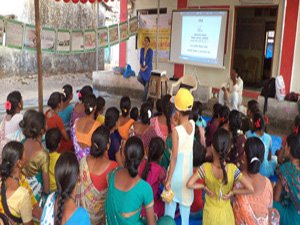
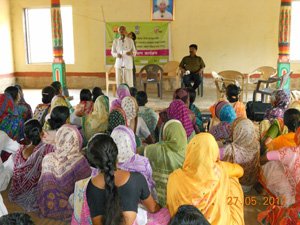
Integrated watershed Management Program (IWMP)
This project was started from Feb. 2011. Main objective of this project is to aware, to train, to make capable those people who really suffering from the problem of water. We are working in Poladpur taluka. IWMP is working in total 19 villages of Poladpur. Three major steps in this program are Awareness, Training & visit to ideal village. We found in both clusters tremendous shortage of water for the purpose of farming, shortage of water is not only for house hold works or farming work but some villages are fighting with the problem of lack of drinking water also. Through this program we are spreading awareness amongst them regarding watershed program, we make them realize that this program is for them only.
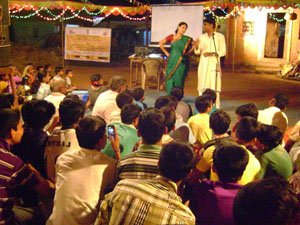
Health Safety / Protection Project (Link Worker Scheme)
1. PRA process usually used for collecting village information from all sectors with the help of History of village, Social map of village, Chapati Diagram, Gaonferi, Natural Map, Wealth chart of village etc. With the help of above all tools information collects from villages. This information uses for various analysis like availability of water resources, earning resources etc. MSVT have done PRA (Village survey for PEYAJAL YOJANA) in 15 villages of Alibag, Shrivardhan, Mangaon, Tala, Pen, Pali talukas of Raigad district in the month of august 2013. This program was for two days in single village. All the population of village covered in this process. Gramsabhas were attended by our PRA leaders. They have taken Expected Plan for water supply from the villagers in Gramsabha with the consent of all.
2. MSVT have done PRA (Village survey for Livelihood development & water supply resources) in 17 villages of Pen taluka- Raigad district in the month of August 2013. This program was for one day at every village. All the population of village covered in this process. Our Leaders have taken Expected Plan for water supply as well as demands & plans for livelihood activities from the villagers with the consent of all.


This project was started from Sept. 2011. Main objective of this project is to aware, to train, to make capable those people who really suffering from the problem of water. We are working in Mangaon taluka. WGDP is working in total 32 villages of Mangaon. Three major steps in this program are Awareness, Training & visit to ideal village. We found in both clusters tremendous shortage of water for the purpose of farming, shortage of water is not only for house hold works or farming work but some villages are fighting with the problem of lack of drinking water also. Through this program we are spreading awareness amongst them regarding watershed program, we make them realize that this program is for them only.

This program was started from September 2011. Basically we work in the rural areas of raigad district. We cover more than 100 villages of Raigad district in our work. Micro Insurance targets the rural people who are unable to insure their lives because of low financial ability. This scheme is made for those people who work on daily wages or working on temporary basis & earning low. This program provides them life cover as well as bonus on maturity. Micro Insurance contains 2 products called Jivan Madhur, Jivan Deep & Jivan Mangal. Maximum limit of Madhur is 30,000 & Mangal is 50,000.

ICTC started from 1st Feb.2011. It covers all the part of Raigad District. Main purpose of starting own ICTC of our trust is to make easier the testing of blood samples which are collected in our various project’s camps. It helps us to cover more & more target in less time. We are having the councilors & technicians who can visit the sites of camps & giving the services to the people.
Area Wise Details Of Programs Currently Run By The Ngo
| Sr. No. | Name of the Project | Work Location | District |
|---|---|---|---|
| 1 | Awareness Programs (Dec. 2004 to till Date) | 2004 :- Raigad 2005 :- Raigad, Ratnagiri 2006 :- Thane 2007 :- Thane 2008 :- Parabhani 2009 :- Raigad 2010 :- Sangali 2012 :- Pune, Raigad 2013 :- Raigad | Mentioned Districts of State |
| 2 | Bharat Nirman Rural Water Supply system (1st Feb. 2008 to till date) | Taluka’s Poladpur, - 190 villages Panchayats. Mahad – 128 Vilages Panchayat. | Raigad District |
| 3 | Safe Health Project TI- Migrant (1st Dec. 2008 to till date) | Taluka’s Pen, Karjat, Khopoli, Khalapur | Raigad District |
| 4 | Safe Health Project TI- FSW (1st July 2009 to 31st Mar. 2012) | Taluka’s Pen, Karjat, Khalapur, Roha, Alibag, Mahad, Pali | All Parts of District Raigad |
| 5 | Link Worker Scheme (1st Mar. 2010 to till date) | Taluka’s Pen, Uran, Panvel, Karjat, Khalapur, Roha, Alibag, Tala, Shriwardhan, Mangaon, Mhasala, Murud, Mahad, Poladpur | All Parts of District Raigad |
| 6 | Integrated Counseling & Testing Center (ICTC) (1st Jan. 2011 to till date) | Taluka’s Pen, Uran, Panvel, Karjat, Khalapur, Roha, Alibag, Tala, Shriwardhan, Mangaon, Mhasala, Murud, Mahad, Poladpur | All Parts of District Raigad |
| 7 | T.B. Awareness Programme (1st Mar. 2011 to till date) | Taluka’s Pen, Uran, Panvel, Alibag, Mahad, Poladpur, Mangaon | District Raigad |
| 8 | Micro Insurance (1st Sept. 2011 to till date) | All talukas in Raigad district | District Raigad |
| 9 | Integrated Watershed Management Program (IWMP) (1st Feb. 2012 to till date) | Taluka’s Poladpur, -19 villages | District Raigad |
| 10 | Western Ghat Develop -ment Program (WGDP)(1st Aug. 2012 to till Date) | Taluka’s Mangaon – 32 villages | District Raigad |
13.Child Marriage Free India Campaign
Kailash Satyarthi Children's Foundation (KSCF), founded by Nobel Peace Prize laureate Kailash Satyarthi, has launched a nationwide campaign & Child Marriage Free India’. This three-year campaign will reach five thousand villages in the country. More than one crore people will be involved in the campaign to create awareness against social evils. Its core objective is to reduce the number of child marriages by 10 percent by 2025, from the current 23.3 percent.
“Child Protection Project” has been launched from April 2023 by Maharashtra Samajik Vikas Trust (MSVT) under Kailash Satyarthi Children's Foundation USA (KSCF US). Raigad and Ratnagiri districts are included for this program. The organization has selected 50 villages from Raigad and 50 villages from Ratnagiri district.
Maharashtra Samajik Vikas Trust (MSVT) is committed to working towards the betterment of underprivileged sections of society, most importantly focusing on uplifting the lives of underprivileged children and women that brings positive change to community. Organization is working actively on following issues of Child Marriage, Child Trafficking, Child Labour and Child Sexual Abuse. The organization has participated in and organized the Child Marriage Free India Campaign.
Our team is constantly working on awareness of child marriage free India campaign in the villages of Raigad and Ratnagiri district, reaching out to villagers, Zilha Parishad schools, private schools/ colleges, Grampanchyat officials, Asha-workers, other health workers, Police Patil, etc. From April 2023 till date we have contacted more than 202127 people in Raigad and Ratnagiri district and taken pledge against child marriage, also we have conducted sessions with all the schools.
The Campaign activities included
16 October 2023 – Child Marriage Free India Campaign Event
The campaign event was conducted in various villages of Raigad and Ratnagiri district covering more than 50 villages in each district in collaboration with DWCD, ICDS and Police departments with notifications issued by the District Magistrate of Raigad & Ratnagiri. All the awareness activities were conducted at the places like schools/ collages, public places (bus stop), gram panchayats, and govt. offices etc.
Campaign highlights:
We have conducted awareness sessions in more than 100 villages on Child marriage issues, Information material/ pamphlets were distributed amongst the people. Our team has organized candle march in the villages, women from villages, health workers, govt. Officials have also joined candle march. We met various groups of societies from all different age groups as well as sectors during this campaign and provided them awareness information about the campaign. They have participated in pledge taking activities also.
Campaign Media Coverage
Background
Child marriage is not just an age-old social evil, but also a heinous crime that robs children of their childhood. Child marriage is a “crime against children” that violates basic human rights, minor girls are forced to marry and live a life of mental trauma, physical and biological stress, domestic violence including limited access to education and increased vulnerability to domestic violence. The consequences of child marriage are severe and extensive. Some of the specific consequences include: early pregnancies leading to complications and higher rate of maternal mortality and death of infants, malnutrition among both the infant and the mother, increased vulnerability to reproductive health, disruption in girl’s education and thereby reduction in opportunities of her personal and professional development, domestic violence and abuse, limited decision making powers in the household, and mental health issues.
India’s Census 2011 revealed 12 million children were married before attaining the legal age, of which 5.2 million were girls. Globally, child marriage is identified as a crime and a menace that needs to be eliminated. It finds space in the UN Sustainable Development Goals, under target 5.3 of Goal 5 that states elimination of all harmful practices, such as child, early and forced marriage and female genital mutilation by 2025.
The latest National Family Health Survey (2019-21) shows that although there is a drop in the overall rate of child marriages, from 26.8% in the National Family Health Survey (NFHS 4) to 23.3% in NFHS-5, it is still high despite laws, programmes and schemes in place to address the issue.
Child Marriage Free India Campaign
Understanding the seriousness of the issue, the Hon’ble Supreme Court of India in W.P. Civil 382 of 2013 pronounced that the sexual intercourse committed by the husband upon his wife being under the age of 18 years with or without her consent can be constituted as rape. To address this, the most definitive and audacious commitment to end child marriage was made with the launch of the Child Marriage Free India campaign.
Child Marriage Free India (CMFI) is a nationwide campaign led by women leaders and a coalition of more than 160 NGOs spanning more than 300 districts working to eliminate child marriage in India. CMFI is working to attain the tipping point of child marriage, after which society does not accept this evil practice, and that will happen when the prevalence of child marriage is brought down to 5.5% by 2030, from the current national prevalence rate of 23.3%. This is being done by initially targeting 257 high-prevalence districts and gradually focusing on all the districts of the country.
Child marriage results in child rape, resulting in child pregnancy, and in a large number of cases, may lead to child deaths. For decades, we have been losing generations of our children to child marriage. The Child Marriage Free India campaign has received extended support from various Departments and Institutions of over 28 States. So far, across India more than 5 crore people have taken the pledge to end child marriage over the last year through the efforts of the Child Marriage Free India Campaign.

The Goal
Demands of The Campaign
Ensure access to free and quality education for all children till class 12 (or 18 years of age, whichever is later)
Dedicated budgetary allocation for schemes and infrastructure for education and vocational training till class 12
Enable real-time attendance data analysis and intervention when irregularities occur
Effective implementation and enforcement of laws against child marriage for all sections of society
Tipping Point to End Child Marriage
Noted child rights activist, author, Supreme Court lawyer and founder of CMFI campaign, Bhuwan Ribhu has authored a book – ‘When Children Have Children: Tipping Point to End Child Marriage’ and put forth a framework advocating a sustainable, holistic and focused strategy with time-bound targets and measurable indicators to make India child marriage free by 2030. This book shows the path to eliminating child marriage in India within the next decade. As suggested by the author in the book, by adopting a systematic, highly focused, and intensive intervention model, over a phased timeline it is possible to reduce the national child marriage prevalence levels to 5.5% —the threshold, the tipping point, beyond which the prevalence is anticipated to diminish organically with reduced reliance on targeted interventions.
Tipping Point Methodology
The aim of reduction of 60% of child marriage (in each of the phases) is assumed to bring down the incidence of child marriage to 5.5% in the next 9 nine years from 2021, from the last available estimates i.e., NFHS-5, till 2030. An additional assumption is that such a focused and elaborate intervention against child marriage would have a ripple effect. The tipping point analysis has been divided into two phases. The first phase will extend over a period of six years, starting in 2021. Subsequently, the second phase will span over a three-year period. It is expected that the national average for child marriage prevalence (percentage women aged 20-24 who were married before 18 years) would decline from 23.3% to 13.7% if the prevalence of child marriage is reduced by 60% in the 257 high-prevalence districts in the first phase followed by a further reduction of 60% in all districts across the country.
To reach the Tipping Point, the author has proposed a strategy at the national and district level.

1. National Level strategy where Governments, Institutions, statutory bodies, etc. work towards prevention, protection, increased investment, improved prosecution, convergence and use of technology for monitoring
2. District Level strategy is similar to national level strategy but includes district administration, Panchayats, civil society, NGOs, other functionaries, parents and children who work collectively to prevent, report, and take action against child marriage
PICKET Strategy to End Child Marriage
Addressing the issue of child marriage, requires a comprehensive and coordinated approach of different government departments, institutions, statutory bodies, and civil society organisations.
Investment in infrastructure, incentivisation and institutions:
Investing in child protection institutions, education, healthcare, justice delivery, and rehabilitation framework builds layers which work to prevent and protect children from abuse and exploitation apart from providing legal and mental health support for girls in child mamages. Infrastructure to support girls at imminent risks of marriages, like institutional alternative care and residential educational facilities are urgently needed to stop their marriages, abuse and d exploitation, and provide them with resilient alternatives Incentives in the form of conditional cash transfers have shown impact in communities to keep girls in schools delaying marriage decisions. Universalization of these to at-risk families has the potential to stop child marriages and trafficking and abuse of girts for both labour and sexual exploitation.
Policy for prevention, protection, prosecution:
it is important to ensure parity in the enforcement of laws, and special laws must prevall over customary or personal laws. The effective implementation and enforcement of existing laws and policies that prohibit child marriage along with swift and decisive justice delivery mechanism are most important steps in checking the prevalence of this crime against children. When prevention of crime is incorporated as a policy, It ensures that the state machinery as well as citizens feel responsible and accountable to prevent child marriage
Convergence of departments, governments and stakeholders in the community:
All schemes and interventions geared towards the protection, prevention, education, health and awareness of children and adults affected by child marriage need to operate in sync with each other. Child participation and empowerment is at the core of such convergence aimed at child centric community development.
Knowledge which equips all the stakeholders to combat child marriage:
Enhancing knowledge empowers children, especially boys, to say no to child marriage. When a young man refuses to marry а minor girt, he breaks the cycle of generations of conditioning. It also gives agency to girls to raise their voice and complain when they are forced for marriage against their will on violation of law. When children, parents, community members and stakeholders participate in decision making equipped with correct and latest knowledge, it can lead to collective action to prevent child marriage.
Ecosystem where child marriage does not thrive:
Central to the PICKET strategy is an ecosystem where child marriage is non-existent. In a society where child marriage is pervasive, multi-pronged intervention at all levels is required. To change the societal perception, behavicur and acceptance towards child marriage, the response at scale requires and ecosystem level retaliation
Technology for monitoring and deterrence to combat child marriage:
Enabling real-time attendance data analysis will help reduce child trafficking, child mamage and drop-out rate in schools Different states are aiready using technology for awareness campaigns, supporting and monitoring programme interventions, augmenting education and skills outreach. The use of machine learning and artificial intelligence needs explorations in support of child protection and creating a safe and ham-free ecosystem for children

Case Study
Aasma Shikha (name changed), a 16-year-old girl from a village of Karjat Taluka, belongs from a modest family, found herself entangled in a distressing situation. What began as a blossoming romance with a boy from Kolhapur was living here for work. Situation took a dark turn when girl decided to leave school permanently for that boy and run away from home without informing anyone in family.
Aasma’s family logged in complain at nearest police station regarding their missing daughter. Realizing the need for immediate action, police came together with the team of MSVT extended support to Mina's family by making plan to rescue her from this whole situation. Team contacted Aasma and won her trust by making her believe that team is with her and will help her in marrying to that boy whom she loves.
She started opening up with the team and talking about her relationship with that boy. Team had investigated about the boy, his family background etc. and came to know that he is already married in Kolhapur and having a son. But Aasma was not ready to believe. Police has taken that boy into custody and interrogated to the boy he admitted his the truth. MSVT’s team has taken Aasma in front of boy and make his confess his truth. Aasma’s trust was broken, she realised the fact that she is cheated. Aasma admitted that he had physically abused her many times and family was keep telling her that he is cheating her but she was not mature enough to see the reality.
Aasma was not ready to live with her family due to social fear but MSVT team has counselled her and family time to time. Mina's case serves as a touching example of how our team interventions can empower vulnerable individuals and families to break free from the shackles of harmful practices. By combining legal support with community awareness, the NGO played a crucial role in preventing a child marriage and fostering positive change in the village. Now Aasma has been re enrolled in school and is continuing with her studies, her behavior towards family and society is changes, she is more aware and mature now and able to differentiate the good and bad for her future and family.
![]()
